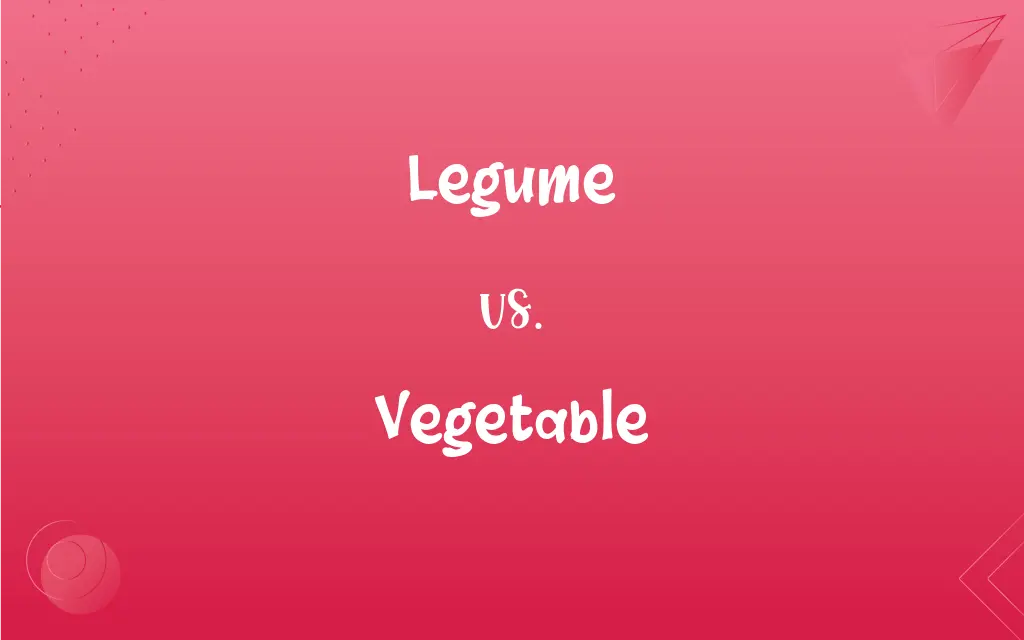Legume vs. Vegetable: What's the Difference?
Edited by Aimie Carlson || By Janet White || Updated on October 7, 2023
A legume is a plant or its seed from the Fabaceae family, while a vegetable is an edible plant or part of a plant used in cooking.

Key Differences
Legumes and vegetables, while both being plant-based food sources, differ significantly in their botanical definitions and nutritional profiles. A legume specifically refers to plants or their seeds from the Fabaceae family. This category includes beans, lentils, and peas. They are known for their ability to fix nitrogen from the atmosphere, benefiting the soil in which they grow.
On the other hand, the term vegetable is broader and denotes any edible plant or part of a plant used in cooking. This encompasses a wide range of items, from roots like carrots and tubers like potatoes to leaves such as spinach. Vegetables are a vital component of our diets, supplying essential vitamins, minerals, and fiber.
From a nutritional standpoint, legumes stand out for their protein content. They are a primary protein source for many who follow vegetarian or vegan diets. Rich in complex carbohydrates and fiber, they also contribute to sustained energy and digestive health.
Vegetables, with their diverse range, offer an array of nutrients. Dark leafy greens are rich in iron and calcium, while cruciferous vegetables like broccoli offer compounds beneficial for detoxification. Regardless of their differences, both legumes and vegetables play an integral role in a balanced diet, promoting overall health.
Comparison Chart
Definition
Plants/seeds from the Fabaceae family
Edible plant or part of a plant used in cooking
ADVERTISEMENT
Nutritional Highlight
Protein
Varies (e.g., Vitamins, Minerals)
Examples
Beans, lentils, peas
Carrots, spinach, broccoli
Soil Benefit
Fixes nitrogen
Depends on the vegetable
Common Use
Stews, salads
Steamed, roasted, raw in salads
Legume and Vegetable Definitions
Legume
Plants from the Fabaceae family.
Chickpeas, a type of legume, are rich in protein.
ADVERTISEMENT
Vegetable
Can be consumed cooked or raw.
I prefer my vegetables grilled.
Legume
Seeds that fix nitrogen in soil.
Farmers often plant legumes to improve soil health.
Vegetable
Plants cultivated for culinary use.
The garden produced an abundance of fresh vegetables.
Legume
Edible seeds like beans and lentils.
I added black beans, a legume, to my salad.
Vegetable
Edible parts of plants used in cooking.
Broccoli is my favorite vegetable.
Legume
Plants with pod-bearing seeds.
Peas, a common legume, grow in green pods.
Vegetable
Source of various vitamins and minerals.
Eating a variety of vegetables ensures nutritional balance.
Legume
A plant of the pea family.
Vegetable
A plant cultivated for its edible parts, such as the roots of the beet, the leaves of spinach, the flower buds of broccoli, or the fruit or seeds of certain species, as beans, corn, and squash.
Legume
A pod of such a plant, which splits into two valves with the seeds attached to one edge of the valves.
Vegetable
The edible part of such a plant.
Legume
Such a pod or seed used as food. Peas, beans, and lentils are legumes.
Vegetable
A member of the vegetable kingdom, especially a green plant.
Legume
(botany) The fruit or seed of leguminous plants (as peas or beans) used for food.
Vegetable
Offensive Slang One who is severely impaired mentally and physically, as by brain injury or disease.
Legume
(botany) Any of a large family (Fabaceae, syn. Leguminosae) of dicotyledonous herbs, shrubs, and trees having fruits that are legumes or loments, bearing nodules on the roots that contain nitrogen-fixing bacteria, and including important food and forage plants (as peas, beans, or clovers).
Vegetable
Of, relating to, or derived from plants or a plant
Vegetable dyes.
Legume
(botany) A pod dehiscent into two pieces or valves, and having the seed attached at one suture, as that of the pea.
Vegetable
Made from or with edible plants or plant parts
Vegetable lasagna.
Legume
A pod dehiscent into two pieces or valves, and having the seed attached at one suture, as that of the pea.
Vegetable
Growing or reproducing like a plant.
Legume
The fruit of leguminous plants, as peas, beans, lupines; pulse.
Vegetable
Any plant.
Legume
An erect or climbing bean or pea plant of the family Leguminosae
Vegetable
A plant raised for some edible part of it, such as the leaves, roots, fruit or flowers, but excluding any plant considered to be a fruit, grain, herb, or spice in the culinary sense.
Legume
The fruit or seed of any of various bean or pea plants consisting of a two-valved case that splits along both sides when ripe and having the seeds attached to one edge of the valves
Vegetable
The edible part of such a plant.
Legume
The seedpod of a leguminous plant (such as peas or beans or lentils)
Vegetable
A person whose brain (or, infrequently, body) has been damaged so that they cannot interact with the surrounding environment; a person in a persistent vegetative state.
Legume
High in protein and fiber.
Legumes are a dietary staple for many vegetarians.
Vegetable
Of or relating to plants.
Vegetable
Of or relating to vegetables.
Vegetable
Of or pertaining to plants; having the nature of, or produced by, plants; as, a vegetable nature; vegetable growths, juices, etc.
Blooming ambrosial fruitOf vegetable gold.
Vegetable
Consisting of, or comprising, plants; as, the vegetable kingdom.
Vegetable
Plants having distinct flowers and true seeds.
Vegetable
A plant. See Plant.
Vegetable
A plant used or cultivated for food for man or domestic animals, as the cabbage, turnip, potato, bean, dandelion, etc.; also, the edible part of such a plant, as prepared for market or the table.
Vegetable
A person who has permanently lost consciousness, due to damage to the brain, but remains alive; sometimes continued life requires support by machinery such as breathing tubes. Such a person is said to be in a vegetative state.
Vegetable
Edible seeds or roots or stems or leaves or bulbs or tubers or nonsweet fruits of any of numerous herbaceous plant
Vegetable
Any of various herbaceous plants cultivated for an edible part such as the fruit or the root of the beet or the leaf of spinach or the seeds of bean plants or the flower buds of broccoli or cauliflower
Vegetable
Of the nature of or characteristic of or derived from plants;
Decaying vegetable matter
A mineral deposit
Mineral water
Vegetable
Diverse category including roots, stems, and leaves.
The vegetable section at the store was vast and colorful.
FAQs
What makes legumes unique from other vegetables?
Legumes are from the Fabaceae family and can fix nitrogen in the soil.
Can you name a few common legumes?
Yes, beans, lentils, and peas are examples of legumes.
Are all legumes vegetables?
While all legumes are technically vegetables, not all vegetables are legumes.
Why are legumes beneficial for farming?
Legumes can fix atmospheric nitrogen, enriching the soil for subsequent crops.
Are mushrooms considered vegetables?
Mushrooms are fungi and not botanically classified as vegetables, though they're used as such in cooking.
Why are legumes sometimes called "pulses"?
"Pulses" refer specifically to the dried seeds of legume plants.
Which provides more dietary fiber, legumes or vegetables?
Both can be high in fiber, but legumes generally provide more fiber per serving.
Which vegetables are rich in iron?
Dark leafy greens like spinach are rich sources of iron.
Are potatoes considered legumes?
No, potatoes are tuberous vegetables, not legumes.
Which is higher in protein, legumes or vegetables?
Legumes are generally higher in protein compared to most vegetables.
Are peanuts considered legumes?
Yes, peanuts are a type of legume, not a nut.
Are legumes suitable for gluten-free diets?
Yes, legumes are naturally gluten-free but check for cross-contamination.
Are tomatoes fruits or vegetables?
Botanically, tomatoes are fruits, but they're treated as vegetables in culinary contexts.
Are peas a type of legume or vegetable?
Peas are legumes and also considered vegetables in culinary terms.
What is the healthiest way to consume vegetables?
Methods like steaming or roasting preserve the most nutrients, though it varies by vegetable.
Which vegetable is highest in Vitamin C?
Bell peppers, especially red ones, are exceptionally high in Vitamin C.
Can you eat all parts of a vegetable?
It depends on the vegetable; some parts can be inedible or toxic.
What's the difference between root vegetables and legumes?
Root vegetables are plant roots consumed as food, while legumes are Fabaceae plants or their seeds.
Which has more varieties, legumes or vegetables?
Vegetables, being a broader category, have a wider range of varieties compared to legumes.
Are canned legumes as healthy as fresh ones?
Canned legumes can be nutritious but may have added sodium; rinsing can help reduce it.
About Author
Written by
Janet WhiteJanet White has been an esteemed writer and blogger for Difference Wiki. Holding a Master's degree in Science and Medical Journalism from the prestigious Boston University, she has consistently demonstrated her expertise and passion for her field. When she's not immersed in her work, Janet relishes her time exercising, delving into a good book, and cherishing moments with friends and family.
Edited by
Aimie CarlsonAimie Carlson, holding a master's degree in English literature, is a fervent English language enthusiast. She lends her writing talents to Difference Wiki, a prominent website that specializes in comparisons, offering readers insightful analyses that both captivate and inform.































































